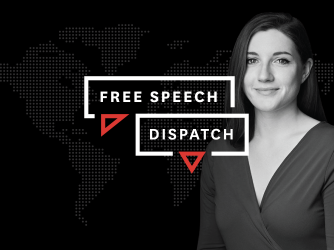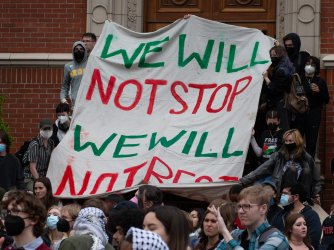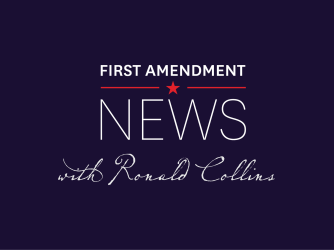Table of Contents
DOJ Demands Clarity from UNM While Mandating Confusing Sexual Harassment Policy

This week on The Torch, FIRE is providing an in-depth look at the letter of findings the Department of Justice (DOJ) sent to the University of New Mexico (UNM) last week at the conclusion of its investigation into the university’s sexual misconduct policies. Among DOJ’s objections to UNM’s policies is the following troubling observation: “At the outset of [DOJ’s] investigation, the University had in place a labyrinth of 17 outdated policies and procedures related to sexual assault and sexual harassment, many in conflict with each other and with federal regulations and guidance on Title IX.”
FIRE agrees with DOJ that university policies must be clear and consistent in order to safeguard students’ rights—and, thankfully, UNM has already begun to untangle its policy web. Unfortunately, DOJ itself has mandated policies that are anything but clear.
Unclear and conflicting policies have been a focus of FIRE’s work throughout our existence. Most colleges and universities across the country maintain a set of policies that leave students unsure about what expression will be censored or result in punishment. The vast majority of colleges advertise a commitment to free speech while also vaguely articulating rules against expression that is usually protected by the First Amendment. These rules threaten campus discourse both when they are enforced and when students self-censor in order to avoid potential punishment. In 2014, FIRE even called UNM out on such a policy and named it our Speech Code of the Month—inspiring UNM to revise that speech code.
As FIRE repeatedly reiterates in our letters to institutions, the Supreme Court of the United States has held that a policy or regulation is said to be unconstitutionally vague when it does not “give a person of ordinary intelligence a reasonable opportunity to know what is prohibited, so that he may act accordingly.” Grayned v. City of Rockford, 408 U.S. 104, 108–09 (1972). Public schools and private schools that promise their students free expression must maintain policies that are clear enough for students to exercise their rights fully without fear of reprisal.
But students certainly won’t be able to do so under the policy scheme mandated by DOJ.
First, some background. There are two types of sexual harassment that are punishable by government entities (including public schools) consistent with the First Amendment: hostile environment harassment and quid pro quo harassment. In OCR’s 2001 Revised Sexual Harassment Guidance, the agency explains these types of harassment and notes that generally, students can engage only in hostile environment harassment, since they typically “are not generally given responsibility over other students”—in other words, they can’t offer anything “quid pro quo.” The Supreme Court has held that student-on-student sexual harassment is targeted, discriminatory conduct “that is so severe, pervasive, and objectively offensive, and that so undermines and detracts from the victims’ educational experience, that the victim-students are effectively denied equal access to an institution’s resources and opportunities.” Davis v. Monroe County Board of Education, 526 U.S. 629 (1999). Outside that narrow definition—with its subjective and objective components—student speech remains protected.
DOJ now asserts that in addition to these types of harassment, there is a broader category of sexual harassment that colleges must investigate and record. DOJ defines that broader category of sexual harassment as “unwelcome conduct of a sexual nature,” including verbal conduct, or speech. And it is explicit in its letter to UNM: “Unwelcome conduct of a sexual nature … constitutes sexual harassment regardless of whether it causes a hostile environment or is quid pro quo.”
As FIRE has explained both in this context and in the context of the 2013 “blueprint” letter from DOJ and the Department of Education promulgating the same definition, such a subjectively defined and nearly unlimited range of speech could include innocuous jokes, conversations about literature that some find offensive, or even discussions about matters of public concern relating to sex. A huge amount of speech that does not rise to the Davis standard could fall squarely within DOJ’s broad definition of “sexual harassment.”
DOJ’s theory seems to be that requiring investigations of protected speech isn’t a problem because students won’t be punished. Never mind the fact that students will be left unsure, for an indefinite period of time, whether their standing with the school is safe or whether they will be branded a sexual harasser for their constitutionally protected expression. And never mind the fact that many students will likely choose not to engage in what could be important and insightful protected expression on matters relating to sex, in order to avoid an investigation, potential punishment, and having their name on a secret list of problem students.
If that weren’t enough, DOJ’s letter repeatedly calls on UNM to “stop[] harassment” (on page 2) and tell its students that the “university does not tolerate … sexual harassment” (on page 7), broadly speaking. It is far from clear, therefore, that a university attempting to follow DOJ’s directives would not punish a student engaging in so-called “sexual harassment” outside the boundaries of Davis.
The bottom line is this: If certain types of speech are defined as harassment, students are going to steer clear. No rule-abiding community member with common sense is going to see a policy defining “sexual harassment” and think, “Oh, but unless the policy specifies punishable sexual harassment, I’m totally allowed to do it.” If students did have that attitude, schools would do well to revise the rest of their codes to define punishable plagiarism and punishable theft, too.
On the flip side, how safe from harassment can students possibly feel when they are being told that institutions may freely choose not to punish students whom the Department of Justice has defined as sexual harassers? After all, DOJ states in its letter that the narrower definition of harassment—that of hostile environment harassment—“is the threshold for determining the school’s obligation under Title IX.” Much of DOJ’s focus on clarity relates to ensuring potential complainants know their rights and options, but DOJ’s harassment scheme is likely to leave those students in the dark, too.
There’s a simple way for universities to protect students from real harassment without infringing on their First Amendment rights (or the promises of free speech most private schools make to their students): They can incorporate the Davis standard into their policies. This standard, set forth by the nation’s highest court, has remained the same since it was announced and properly balances the interests of one student’s right to speak and another student’s right to receive his or her education. Meanwhile, standards from DOJ and the Department of Education’s Office for Civil Rights (OCR) have shifted over the years, leaving both schools and students confused about what speech is allowed and what isn’t.
In its 2001 Guidance, OCR reaffirmed that the Davis standard was correct, reaffirmed its previous definition of hostile environment harassment (“conduct of a sexual nature is sufficiently severe, persistent, or pervasive to limit a student’s ability to participate in or benefit from the education program, or to create a hostile or abusive educational environment”), and opined that both definitions “capture the same concept.” At that time, OCR wasn’t bothered by the difference between “severe, pervasive, and objectively offensive” from Davis and “severe, persistent, or pervasive” from its own guidance. Yet in DOJ’s letter to UNM, the agency criticizes the difference between two university policies thusly: “[U]nder [one policy], persistent sexual misconduct would constitute a hostile environment, whereas under [another policy], it would not.”
In the 2001 Guidance, OCR also cited a request “to provide distinct definitions of sexual harassment to be used in administrative enforcement as distinguished from criteria used to maintain private actions for monetary damages” and declined to do so because
schools benefit from consistency and simplicity in understanding what is sexual harassment for which the school must take responsive action. A multiplicity of definitions would not serve this purpose.
Indeed, a multiplicity of definitions would not serve this purpose. Nor would having a separate definition for harassment that must be investigated and harassment that must be punished.
In May 2013, OCR strayed further from Davis. Concluding their investigation of the University Montana, DOJ and OCR demanded that UM define “sexual harassment” as “any unwelcome conduct of a sexual nature” and called its instructions to UM “a blueprint for colleges and universities throughout the country to protect students from sexual harassment and assault.” But when UM finally published its new, agency-approved policy, its definition of harassment fell short of the “blueprint” (though it still threatened protected expression). After all this, how could institutions reasonably ascertain the proper boundaries of their sexual harassment policies, according to DOJ and OCR? Erring on the side of not risking federal funding, schools across the country have adopted unconstitutional policies that mirror the “blueprint” despite the fact that UM itself got away with not doing so.
With DOJ doubling down on the “blueprint,” it is almost inevitable that more institutions will adopt severely speech-restrictive policies and launch unwarranted investigations into protected speech in an effort to avoid trouble with the federal government. As a result, students and professors nationwide will find themselves censored, punished for protected speech, or choosing to self-censor out of caution.
The solution, again, is for a national return to Davis—as a standard for prohibitable expression, as a standard for what schools should investigate, and as a standard for what schools should punish. Until government agencies and institutions of higher education embrace the Davis standard, clarity will remain elusive.
Recent Articles
FIRE’s award-winning Newsdesk covers the free speech news you need to stay informed.

How court rulings in Hong Kong and Australia threaten the global internet

Another Connecticut town tramples Constitution with onerous town green rules

Majority of college students support Israel/Gaza campus protests, 1 in 10 actually participate in them
